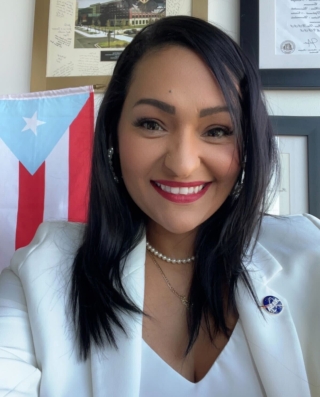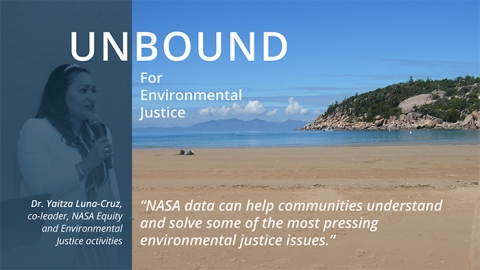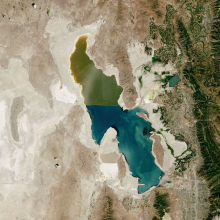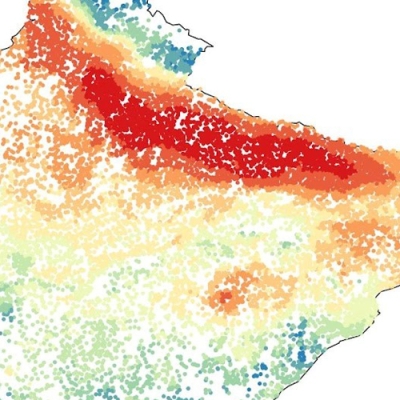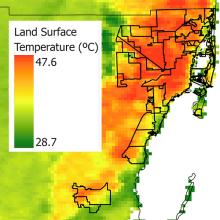When Hurricane Maria hit Puerto Rico in 2017, atmospheric scientist Dr. Yaítza Luna-Cruz was focused on two important things: providing accurate weather briefings for the Department of Defense and wanting to know if her family was safe back home.
“The devastation was unimaginable. More than 3,000 people died and 1.5 million people on the island lost power. It became the longest blackout in U.S. history and my family spent nine months without power,” said Luna-Cruz.
Luna-Cruz, now a program scientist for NASA’s Chief Science Data Office, says recent studies show that areas with the most severe damage and prolonged problems in Puerto Rico were also areas of lower socioeconomic status. These communities lacked the resources and the representation to repair damage quickly, leading to long-term lack of access to electricity, water, and other critical supplies.
To end such inequities, NASA is joining a global social and scientific effort addressing the unfair health and safety risks communities and countries experience by threats from the natural and built environments. Such threats include living in areas prone to dangerous flooding, toxic air pollution, and severe storms including typhoons and hurricanes. This effort is called environmental justice, and one of its main tenets is for scientific researchers, institutions, and agencies to help at-risk people find solutions to their environmental problems by ensuring they have free and open access to Earth science research and data.
Luna-Cruz is one of the NASA leaders heading the agency’s environmental justice initiatives aimed at increasing access to Earth science data by creating programs that eliminate barriers to research and include at-risk communities in scientific and mission-planning processes. She co-leads activities such as the NASA Science Mission Directorate (SMD) Open-Source Science Initiative (OSSI) and the Transform to Open Science (TOPS) mission along with NASA Earth Science Division (ESD) equity and environmental justice (EEJ) initiatives that are part of the NASA Equity Action Plan.
Before joining NASA, Luna-Cruz’s environmental science-related work included her position supporting first responders and operations for U.S. and international agencies. In her role as a shift lead for the Technical Reachback division of the Department of Defense’s Defense Threat Reduction Agency, Luna-Cruz provided modeling for extreme weather events and atmospheric transport to support around-the-clock operations worldwide. Luna-Cruz also managed projects for a climate change analytics company where she analyzed the types of data different business sectors need to create solutions to address global climate change.
From her years growing up in Puerto Rico to her current work at NASA, Luna-Cruz is a firm believer that "science with purpose" is a key aspect to more broadly foster environmental justice.
How have environmental injustices personally affected you?
I was born and raised in Puerto Rico. In Puerto Rico, like in many other places in the United States, we are facing multiple environmental injustices from slow disaster recovery after extreme weather events, water, air and soil pollution, loss of coastal areas, and dangerous exposures to hazardous and toxic substances.
One of the biggest, clearest examples of environmental inequalities is Hurricane Maria in 2017. Six years later, the recovery is still a work in progress. I decided a long time ago that the best way to channel all my frustration from experiencing those and many other injustices was working towards making a difference using my science and educational activities as a catalytic change agent. I think experiencing all the inequalities gave me the power to continue working hard to find solutions, to increase the participation of underserved communities, and find or amplify our voices in the process.
What are your key concerns regarding environmental justice?
In terms of understanding the natural environment, I think we are on a good track to put the pieces together and understand critical environmental issues. Yet, I think we are missing the human and social part of it. We are missing getting at-risk communities involved in the decision-making process. We also need to avoid using a cost-versus-benefits business case perspective to show the value of environmental justice, and instead treat it simply as the morally and ethically right thing to do. As a data provider agency, NASA can make a huge difference in empowering the communities we serve with data and knowledge they can use to understand and inform their decisions. We can promote a co-development culture in which everyone becomes part of the solution.
How does NASA define environmental justice and environmental justice communities?
At NASA, we are adopting the White House Environmental Justice Advisory Council’s definition. This means NASA’s data, products, and personnel work and policies can and should include the just treatment and meaningful involvement of all people regardless of race, color, national origin, income, or ability. It also means environmental justice principles should be used in the development, implementation, and evaluation of programs, practices, and activities that affect human health and the environment.
Likewise, we are adopting the definition for environmental justice communities as geographic locations within the U.S. and its territories with significant representation of persons of color, low-income persons, indigenous persons, or members of Tribal nations where such individuals experience or are at risk of experiencing higher or more adverse human health or environmental outcomes.
In what ways can NASA promote and practice environmental justice?
Data inform decision-makers, but a lack of data also influences decision-making. In multiple environmental justice assessments, communities emphasize the need for better accessibility and equity in data distribution. NASA can have a significant impact on increasing accessibility and equity in environmental data distribution. We currently have around 80 petabytes of Earth science data that are free, open, and available. When these data are combined with socioeconomic data, we enable research and applications for environmental justice that can be used to inform communities and decision-makers.
Within NASA’s Earth Science Division, we are working hard to create more data awareness and make agency data more usable and available for different communities. We also engage the communities in the process to identify [their] needs. One of the key factors for tackling environmental injustice is understanding how multiple factors and events converge on vulnerable communities, and this can be possible through the integration and visualization of critical data. We also understand that community engagement is crucial, and we are doing our best to listen and be a better resource for those communities.
What are some of NASA’s key environmental justice initiatives?
During the last year-and-a-half, we have made tremendous advancement on environmental justice-related activities across the Chief Science Data Office. These include:
OSSI
The NASA Open-Source Science Initiative (OSSI) is a comprehensive program of activities to enable and support moving science towards openness, including facilitating policy adjustments, supporting open-source software, and enabling cyberinfrastructure. OSSI will broaden participation by historically underrepresented communities, increase accessibility of knowledge, and help communities embrace new technologies.
At its core, open science principles embrace transparency, collaboration, and participation. A commitment to open science can only be realized with an equally strong commitment towards diversity, equity, inclusion, and accessibility. Promoting these values is not only fair for everyone—it also improves the quality of science. I always say that collective intelligence drives the most creative solutions, which means we need diversity of thinking. In other words, open science is indeed an opportunity for equitable, accessible, and just climate and environmental science.
TOPS and TOPST
NASA’s Transform to Open Science (TOPS) mission is an initiative designed to rapidly transform agencies, organizations, and communities to an inclusive culture of open science. The Transform to Open Science Training (TOPST) initiative solicits proposals to advance open science literacy for all who do research on topics relevant to NASA’s Science Mission Directorate through training and workshops targeting audiences from undergraduate students to established scientists and managers. TOPST is aligned with Focus Area 2 and 3 from the NASA Equity Action Plan: Mission Equity and sets a precedent with a more equitable and inclusive language and requirements that will allow TOPS to minimize or reduce barriers of entry and increase outreach and open science training for underserved communities. The TOPS mission will also engage in a dual-anonymous peer review process to help us ensure fairness in the selection process for NASA’s Research Opportunities in Space and Earth Sciences (ROSES) grant program.
Environmental Justice Data Backgrounder
The agency published an Environmental Justice at NASA Backgrounder in direct response to recommendations from NASA’s Equity and Environmental Justice Virtual Workshop [held on October 20, 2021] and to increase awareness of NASA Earth observation data. The Backgrounder provides information about how NASA data are being used to support environmental and climate justice efforts along with use cases showing how scientists and decision-makers are applying NASA data to assess communities’ vulnerability and exposure to environmental challenges.
VEDA Dashboard-Environmental Justice thematic area
NASA scientists have assembled a dashboard called VEDA—Visualization, Exploration, and Data Analysis. VEDA includes an environmental justice thematic area that brings together many sources of information and tools—for example, socioeconomic data, Earth observations, and analysis via machine learning—to help communities and the public understand environmental disasters and why they have happened. Integration of information like this is critical for informing decision-makers to mitigate future disasters.
UNBOUND-Environmental Justice
The Understanding Needs to Broaden Outside Use of NASA Data (UNBOUND)-Environmental Justice workshops took place in the spring of 2022. The UNBOUND project, which was created by NASA’s Earth Science Data Systems (ESDS) Program, seeks to make NASA data, tools, and resources more usable and accessible to a broader community. UNBOUND-EJ consisted of a series of workshops with data practitioners from 15 new organizations that were not currently using NASA data to help ESDS identify data user needs.
Environmental Justice Data Catalog
NASA’s ESD is constantly expanding awareness, accessibility, and use of Earth science data and enabling contributions to Earth science research and applications. With this in mind, ESDS created the Environmental Justice Data Catalog to provide a central repository of datasets useful for environmental justice research and applications. The catalog contains approximately 140 datasets organized by eight indicators, such as disasters or air quality. Information including spatial resolution, data format, and geographic coverage is provided for each dataset.
Finally, how do pursuing environmental justice and open science contribute to your sense of success?
I’ve learned that what defines your success is the way you serve others—your life of service. I have a vision of doing Science with Purpose, a purpose of helping others to do the same, no matter where you come from, the way you look, or the way you live. For me, environmental justice efforts, open science, science education and outreach, early engagement, mentorship, finding solutions for retention, and creating opportunities for sustainable support are the keys to having a more equitable and inclusive scientific workforce.
